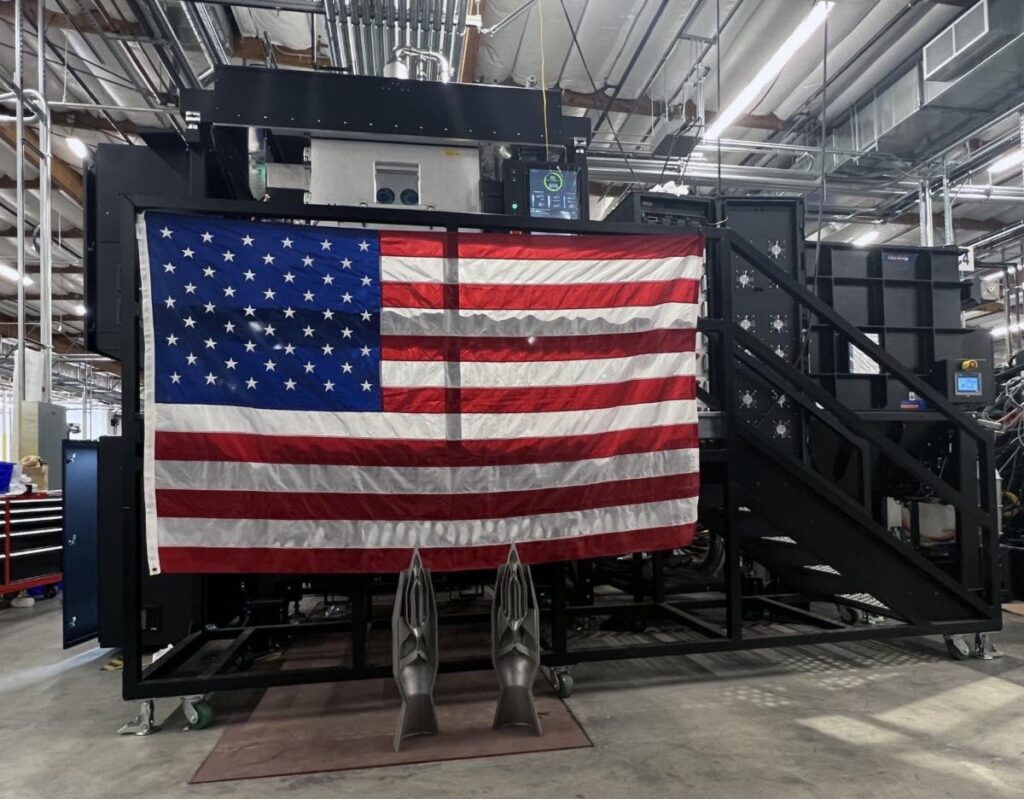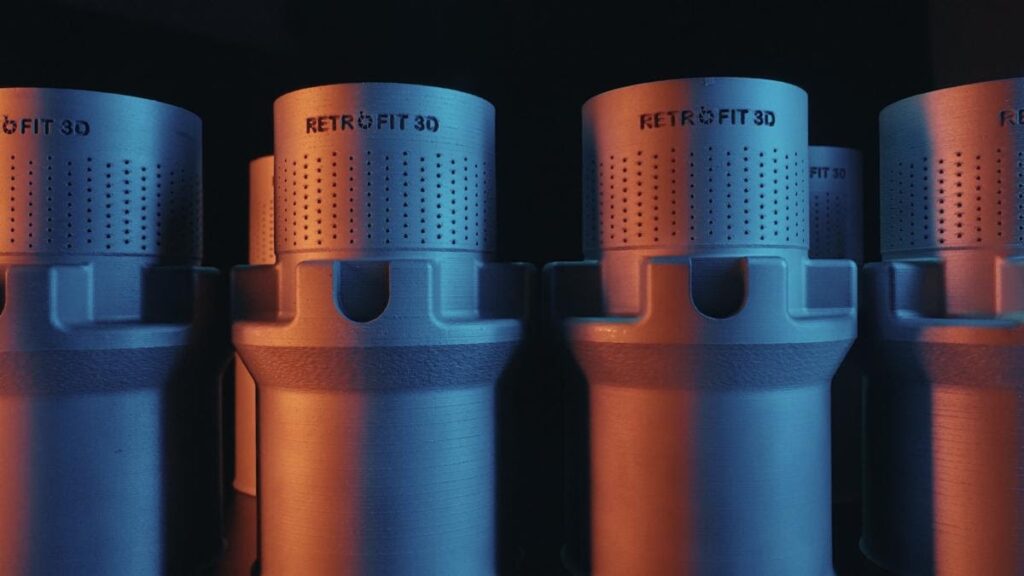To whatever extent a business is successful thanks to specialization, businesses will nonetheless always be holistic entities. A company isn’t a bunch of compartments that all happen to share the same name. Companies are organized wholes, which sink or swim based on how seamlessly the individual parts are interconnected.
As an organization, Velo3D has learned that lesson, and the company’s new CEO, Brad Kreger, seems to have rapidly learned it from paying close attention to the strengths of the company he runs. Formerly Velo3D’s executive VP of operations, Kreger became CEO in December 2023, following founder Benny Buller’s departure.
The founder and CEO leaving as the company’s share price plummeted easily could’ve led to a downward spiral of self-perpetuating bad news. Instead, Velo3D seems to have turned a corner just as seamlessly as 2023 transitioned into 2024.
Seated across from Kreger in a conference room on the Chicago Hilton’s fifth floor, I didn’t get the impression I was looking at an executive who was overwhelmed by the position he’s been thrown into in the last few months. This was particularly striking given how inherently overwhelming the Additive Manufacturing Users’ Group (AMUG) Conference is, with its marathon schedule of networking, workshopping, deal-making, and general gallivanting.
Kreger exuded why he’s exactly what Velo3D needs right now: he was calm. He was also focused, demonstrated by how readily he applied the principles of Velo3D’s strategic pivot to the questions I raised. Above all, I wanted to know how the company manages the twin challenges of going after new customers while simultaneously increasing its attention to its existing ones.
That task is made somewhat less difficult, Kreger noted, since Velo3D primarily targets sectors that demand AM for mission-critical parts:
“If you do too much divergent development, it’s not sustainable,” said Kreger, “so you do have, to some extent, understand the verticals you want to play in. But simply prioritizing listening to customers helps you figure out how you should be budgeting your time and effort. It has also taught us the types of experiences that are generally universal to all users of our technology, at the same time as it’s taught us the specific feature sets that you need for each vertical.
“Some things we’ve been looking at on the more general side are just what impacts the people operating Sapphire machines on a daily basis: increasing machine utilization, improving yields, optimizing workflows, those are pretty common to all of our customers. Investing energy and resources there is really straightforward. When you start to think about particular feature sets, those certainly start to get more tailored, like our investment in achieving the DoD’s STIG compliance for cybersecurity. That’s obviously something that benefits all of our customers, but it still pretty specific to the defense industry.”
Defense is clearly the focal point of the company’s shift. Ursa Major, the Denver-based company attracting DoD attention for its 3D printed rocket motors, was one of the first customers for Velo3D’s new Developer software tool, part of the company’s latest update to its Flow platform.
Developer enables users to transport previous prints, including those from other companies’ machines, to Velo3D’s Sapphire ecosystem. Again, while this is certainly quite an attractive proposition for defense customers, who put a premium on repeatability across different production networks, it’s easy to understand how the appeal generalizes for the entire customer base:
“Developer really speaks to those customers who have already developed parameter sets and don’t want to start back at the beginning,” Kreger said. “We saw that as customers began to really incorporate the technology, and they looked across all the platforms and took note of the differentiators between them. They were essentially saying, ‘I want the scalability I can get out of the Velo3D platform, but I’ve already developed my part on a competing one.’
“And Ursa Major was a great real-world example of that. They were able to port the parameters in and on the very first attempt, print a part that met specifications. In that specific case, the goal was to invest in a feature set that speaks to a particular set of customers, but it’s pretty agnostic in terms of verticals. It’s a balancing act.”
If Velo3D is successful at achieving that balance, it’s largely because the company has exactly the right advantages in an environment where enterprises are still continuously internalizing the need to regain long-term control over their supply chains. One effect of this is that, more than ever, AM customers are looking for opportunities to scale quickly:
“Focusing on scalability has utility across multiple segments, and that’s really the supply chain resilience aspect taking center-stage,” Kreger explained. “If I’m the customer, I want to be able to design a part, print it, print it again a year from now and not have to requalify it, and know that it’s there and that I can move it across multiple different geographies without anything changing.
“Now, for most of the industry, this idea is just a theory, and potential customers have likely heard something similar before. But, once we’re able to get people to really see that, for us, it’s not a theory, it’s something that we do every day in practice, it unlocks their understanding of how that ability can transform the economics of their AM deployment.
“For example, we see a lot of our customers utilize our contract manufacturing network for overflow. You could be an OEM, buy a platform, and get it up to full utilization. If you have excess demand, as a user of our machines, you know that with our scalability and portability, you can push that overflow demand to any one of our contract manufacturing partners to fill the gap, and the parts won’t change.
“So, when you start thinking about the economics of buying a piece of capital equipment, without a contract manufacturing network, your economics are entirely dictated by how much you utilize the platform. Whereas if you have that flexibility, it allows you to keep those tools at less than a hundred percent capacity at all times, because you know you’ve got a place to go for overflow.”
This is precisely the sense in which Velo3D means “scalability”. Its machines can be installed in any contract manufacturing operation, and in the hands of the right operators, the parts will be the same no matter where or when they’re printed. For Velo3D, then, “scalability” means repeatability.
Velo3D bore this concept out in a case study whose results were published a little over a year ago, which involved UK engineering firm IMI Critical and five different contract manufacturers, located in three different countries spanning North America, Europe, and Asia. The company created a print file in 2021 for an oil & gas choke valve, then sent the file to IMI, who locked it in their catalog, then sent it to the contract manufacturers. Each one printed two parts, with each part conforming to one another, to the original print file, and all meeting the American Petroleum Institute (API) standard.
If this sounds like what all metal 3D printing OEMs can do, it’s not — although it is what they’re all trying to do, essentially. The DoD’s growing interest in Velo3D—evidenced by Bechtel Plant Machinery Inc’s (BPMI’s) selection of the company for a U.S. Navy facility that BPMI is building in Florida—is related to exactly the same capabilities that the choke valve case study exemplifies. As Kreger told me,
“Key people at the DoD have figured this out. We’re having a lot of conversations with them around various applications, and one of their biggest focuses is this ability to scale in terms of distributing production at various facilities — without having to constantly revalidate and rescale. And this is specifically a supply chain issue. DoD absolutely has needs for really high complexity parts, but they also have a need for really simple ones. When a bracket or a piece of plumbing, etc, fails, they need to be able to produce those simple parts very rapidly, efficiently, and consistently.
“Now, beyond that, once they’ve incorporated the machines into their supply chains, they can actually start to use them for innovation. That would be cost-prohibitive with casting supply chains. Moving to 3D printing gives them the advantage of this digitally-based inventory immediately, and then also the ability to improve those parts as they go.”
In that same vein, Kreger mentioned that he’s noticed significant momentum lately from the federal government in its advanced manufacturing policy:
“I think they’ve moved from a model in which they’re waiting for industry to evolve solutions entirely on its own, to one where they’re painting a very clear outline for what they want and the road ahead,” said Kreger. “They’re taking a much more active role, and it’s accelerated a lot just in the last six months, from what I’ve seen. Their position seems to be dramatically different from what it was, even comparing the situation now to mid-2023. And every time these sorts of stories like the one with BPMI get publicized, I think it helps more people see the value of AM, and they can see the critical role it can play, especially in helping the US catch up to its competitors.”
The road here was bumpy, but Velo3D got itself to the right position at the right moment. From what I can tell, the right team is in place to keep things headed in the right direction.
Images courtesy of Velo3D
Subscribe to Our Email Newsletter
Stay up-to-date on all the latest news from the 3D printing industry and receive information and offers from third party vendors.
You May Also Like
Gorilla Sports GE’s First 3D Printed Titanium Cast
How do you help a gorilla with a broken arm? Sounds like the start of a bad joke a zookeeper might tell, but it’s an actual dilemma recently faced by...
Nylon 3D Printed Parts Made More Functional with Coatings & Colors
Parts 3D printed from polyamide (PA, Nylon) 12 using powder bed fusion (PBF) are a mainstay in the additive manufacturing (AM) industry. While post-finishing processes have improved the porosity of...
$25M to Back Sintavia’s Largest Expansion of Metal 3D Printing Capacity Since 2019
Sintavia, the digital manufacturing company specializing in mission-critical parts for strategic sectors, announced a $25 million investment to increase its production capacity, the largest expansion to its operations since 2019....
Velo3D Initiates Public Offering in a Bid to Strengthen Financial Foundations and Drive Future Growth
Velo3D (NYSE: VLD) has been among a number of publicly traded 3D printing firms that have attempted to weather the current macroeconomic climate. After posting a challenging financial report for 2023,...



































